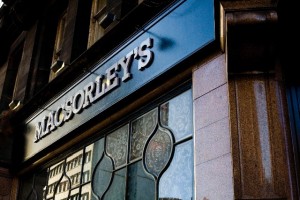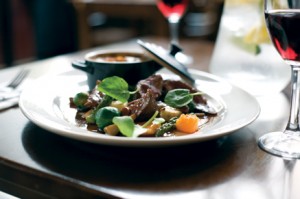 ][1]
][1]Sam Carswell is in charge of the kitchen at Biadh in MacSorley’s Music Bar in Glasgow. The MacSorley’s premises have been a bar for well over a century but the place has enjoyed a new lease of life since it was taken over by the guys behind the Sub Club a couple of years ago.
Although Sam has been working at MacSorley’s since last year, it is only in the last couple of months that everything has been in place for Biadh to bloom. Since launching the spring menu in April, Biadh has created quite a splash with glowing reviews in several newspapers and the type of word of mouth that money can’t buy. His restaurant’s name is pronounced ‘Bee-uch’ and it’s Gaelic for food.
A professional chef for over thirty years, Sam has worked with people like Pierre Koffman and Raymond Blanc. He was also crowned Masterchef in 1998. Older readers may, just, remember Sam from Border TV’s Room With A Spoon show in the Eighties.
 ][3]
][3]Q) Tell us about your career?
SC) I left school at sixteen, much to my father’s chagrin, and started my apprenticeship at the Central Hotel in Glasgow. It was one of the British Transport Hotels which offered the best training at the time. I finished my training at Gleneagles and then went to Jersey where I had my first experience of Michelin level cooking.
I was told by other chefs that I needed London on my CV so off I went. I hated the place but loved my job. Over the years, I’ve moved around and worked with people like Pierre Koffman and Raymond Blanc.
Q) The spring menu in Biadh looks very ambitious for a bar in Scotland. It has a starter which is a roasted pig’s trotter, served with a salty cod brandade, vanilla infused chickpea cream and saffron steamed crayfish. Is Glasgow ready for it?
SC) Glasgow has a long way to go to catch up with Edinburgh in terms of fine dining but what we are trying to do here is give people really fine food, bordering on Michelin level, but at a really affordable price.
People’s perception of food and their expectation of it have definitely risen over the last couple of years. It’s not strange now to see ingredients like frogs’ legs on a menu. Five years ago, people might have said ‘I’m not eating that’ but now they try them and they are loving it.
Q) Scottish ingredients are very prominent on the menu. Was that deliberate?
SC) I wanted the menu to be as Scottish as it could be but I wanted to put a really modern twist on it. It is proper, seasonal, Scottish food.
Recently, in one of the trade mags, there was some guy saying that because of flights disruption, caused by the volcano in Iceland, he couldn’t get any produce. That made me laugh. There is nothing on my menu that I can’t get every day, in season, within a 35-40 mile radius. Sustainability is a good thing. I like using small producers and I like using seasonal produce. It makes sense; ingredients are cheaper when they are in season.
Q) As well as the spring menu, you do a pub classics menu. Why?
SC) We run a menu of pub classics for people who come in and want pub food but we do a modern twist on that as well.
So the steak pie is not shoulder of beef but beef shin. We get the shins, take them off the bone, trim off all the fat and gristle and roll them. They get braised in veal stock for eight hours and then we put a nice puff pastry lid on it and serve it with fresh root vegetables and a decent mashed potato. It’s a deconstructed steak pie but people are loving it.
We also do a take on the gammon steak and egg which is a pave of gammon, crushed potatoes and black olives, a poached duck egg and a tonic wine jus made from Buckfast. We knew we had to get Buckfast in somewhere so we put it in with the gammon dish and it works remarkably well.
Grilled gammon steak with pineapple and egg is something that everybody associates with pub food in Glasgow. We just took it a stage further.
The two menus probably sell 50/50. We get a lot of old chaps coming in with friends during the day and they’ll have three fish suppers and a gammon and egg. They’ll say things like, ‘Son, that was fantastic we’ve been coming to this pub for sixty years and the food is great.’
 ][4]
][4]Q) What difference has the recession made to your job?
SC) The recession makes you think smarter. I don’t think I’ve put fillet steak on a menu in the last five years. We do use high end ingredients like truffles and foie gras but we do it in a way that is economical and people are going to buy it. I think our most expensive course is £13.95. We do dishes which in London would be £25-£30 but we are not in London.
The price of a dish will depend on the margins we need to make but I always ask myself whether or not I would be happy to pay the price I’m thinking of charging for a dish. If not then I’ll change the dish.
One difference is that the lunchtime trade is gone. Night time is fine but we are trying to find ways to bring the lunch trade back.
 ][5]
][5]Q) What chef has really inspired you?
SC) I was in America and I went to eat at Thomas Keller’s French Laundry and that blew me away. I was really inspired by his less is more philosophy. He might do fifteen courses but each one is only three or four mouthfuls and leaves you wanting more. Eating there made me think, ‘Yeah, I’m ready to do another fifteen to twenty years in the kitchen.’
Q) Any kitchen slang, we can print?
CS) We’ll use Americanisms such as ‘We are in the weeds’ rather than ‘in the s**t’ ‘cos we have a couple of girls working in the kitchen. We don’t like to swear in front of the girls but, of course, they swear more than us. I guess it’s just the usual Glasgow slang: Ruby Murray for curries and Fanny Craddock for haddock.
